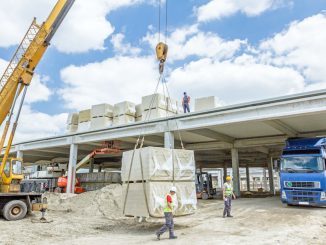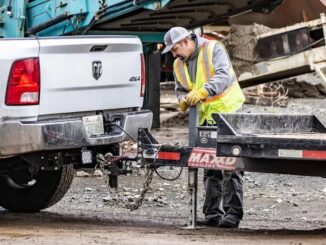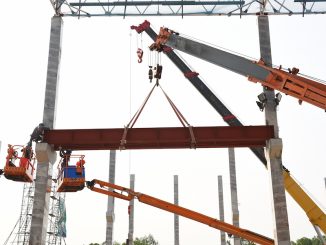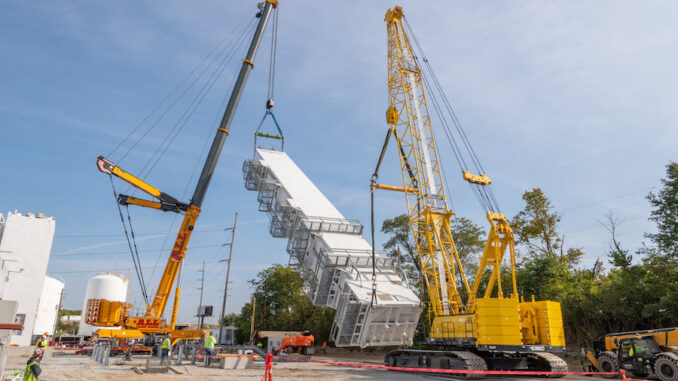
View the complete article here.
Lifting beams and spreader beams play integral roles in ensuring the safe and efficient handling of various loads. These devices, while similar in name, possess unique designs and cater to distinct challenges. In this article, we will cover their fundamental structures—highlighting their individual components—and exploring their differences, applications, and industries where they prove indispensable.
Basic Structure of Lifting Beams and Spreader Beams
Before we discuss the differences and other factors involved with lifting beams and spreader beams, it’s necessary to outline the basis structure of each…
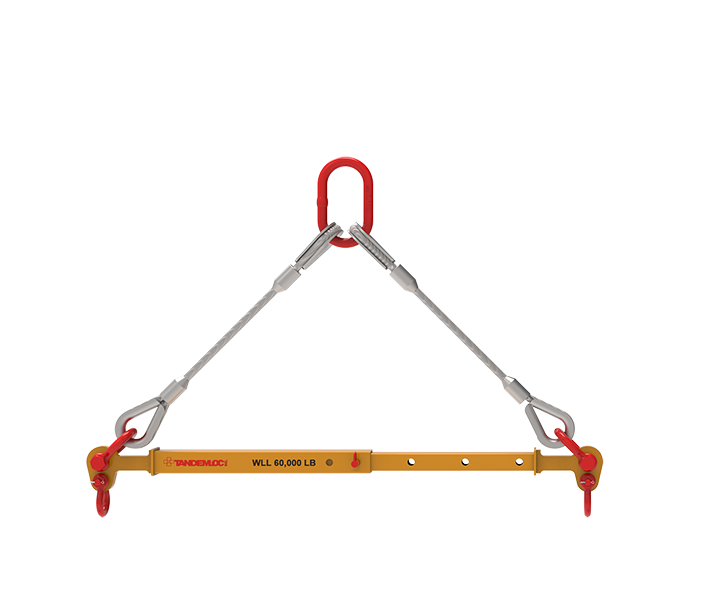
Spreader Beams
Spreader beams are specialized lifting devices designed to distribute a load’s weight across two points, providing stability during lifting operations. They are ideal when handling loads that are long or flexible, or when the load’s lifting points need to be separated or spread apart. The use of spreader beams helps prevent excess force or bending moments on the lifted object, ensuring safer and more balanced lifting procedures.
The key components of spreader beams include:
- Top sling: This is the main attachment point that connects the spreader beam to the crane or lifting device. It often encompasses a sling or rigging system that converges at a central lift point on the beam.
- Bottom slings: These are multiple slings that attach to the object being lifted. They hang vertically from the spreader beam’s multiple connection points, ensuring a balanced lift.
- End fittings: Attached at either end of the beam, these components are used to connect the bottom slings. They might include shackles, hooks, or other specialized fittings.
- Central bar: This is the primary structural component of the spreader beam. It is typically a robust, straight bar that maintains rigidity during the lift and spreads the force across its length.
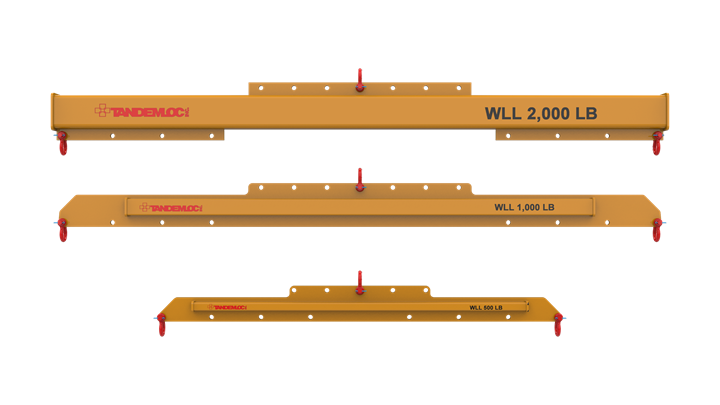
Lifting Beams
Lifting beams are rigid beams equipped with a singular top lifting point and multiple bottom lifting points. They are designed for scenarios where there’s limited headroom—or the load requires more than two lifting points due to its size, shape, or weight distribution. Unlike spreader beams, lifting beams directly handle both bending and shear stresses—as they support the entire weight of the load.
The key components of lifting beams include:
- Singular top lifting point: This is the central attachment point that connects the lifting beam to the crane or hoisting device. It is often a single fixed point located at the beam’s center or a built-in lifting lug.
- Bottom lifting points: These are multiple attachment points located underneath the beam. Depending on the design, these can range from fixed hooks to adjustable lugs—allowing flexibility in connecting to various loads.
- Solid loading bar: The primary structural component of the lifting beam, this bar is typically thicker and more robust than that of a spreader beam. It needs to withstand bending moments, ensuring that the beam remains straight and the load stays balanced during the lift.
Primary Differences Between Lifting Beams and Spreader Beams
In the world of rigging and lifting, the tools and equipment used can define the success and safety of an operation. When it comes to lifting beams and spreader beams—there are various differences to consider, including their designs and configurations, load distribution, headroom, adjustability, complexities, and costs.
Design & Configuration
Spreader beams and lifting beams, while both integral to the rigging and lifting industry, differ fundamentally in their designs and configurations…
A spreader beam has the ability to spread the load between two primary lift points. By doing so, the beam predominantly handles compressive forces—distributing the weight of the load across its length. This design ensures that the beam keeps the lifted object stable, especially when it’s long or flexible. The top sling, or the main attachment point, converges at a central lift point on the beam—while the bottom slings hang vertically from the beam’s multiple connection points, directly attaching to the object being lifted. The spread between the two main points ensures a balanced and secure lifting operation.
In contrast, lifting beams feature a more straightforward design with a singular top lifting point and multiple bottom lifting points. The singular top point attaches the beam to the crane or lifting mechanism. The multiple bottom points, located directly underneath the beam, provide the flexibility to attach to various parts of the load. This design is particularly effective for scenarios where the load requires several attachment points due to its size, shape, or weight distribution. Given that the beam directly supports the entire weight of the load, it undergoes both bending and shear stresses—necessitating a robust and sturdy construction.
Load Distribution of Lifting Beams and Spreader Beams
When it comes to the mechanics of lifting and supporting weights, the way loads are distributed is crucial for both safety and efficiency. Each type of beam, whether spreader or lifting, has been designed with specific load-bearing characteristics in mind…
Spreader beams are designed to manage the weight they lift by distributing it across their length. Their primary role is to counteract compressive forces. The structure of a spreader beam, characterized by its spread between two main lift points, ensures that the force exerted on it is compression—pushing inwards on the beam. This design ensures that longer or more flexible loads remain stable during the lifting process.
Unlike spreader beams, lifting beams have to grapple with a broader range of forces. They are subjected to bending moments due to the load’s weight being suspended from multiple points beneath the beam. In addition, they encounter shear stresses—which arise when the force of the load tries to slide one segment of the beam past another. The robust and solid design of lifting beams equips them to handle these combined stresses effectively, making them versatile tools in lifting varied loads.
Headroom of Lifting Beams and Spreader Beams
The space available overhead, or headroom, is a vital factor in choosing the right lifting equipment. Not only does it influence the safety and efficiency of operations, but it can also determine which type of beam is best suited for a given scenario…
Designed with a spread between two main lifting points, spreader beams tend to have a longer vertical profile—especially when incorporating the necessary slings or rigging systems. This design characteristic means that they generally require more headroom to operate safely and effectively. The need to accommodate both the length of the beam and the additional rigging often means these are preferred in settings where there’s ample overhead space.
On the other hand, lifting beams boast a more compact design—with a singular top lifting point and multiple bottom lifting points located directly beneath the beam. This direct attachment minimizes the vertical space needed for lifting operations, making lifting beams a go-to choice in situations with limited headroom. Their ability to function effectively in constricted spaces without compromising on safety or load-bearing capacity makes them invaluable in many industrial and construction environments.
Adjustability of Lifting Beams and Spreader Beams
The flexibility and adaptability of lifting equipment are paramount, especially when confronted with diverse tasks and varying load types. Both spreader beams and lifting beams offer different degrees of adjustability, catering to specific needs and situations…
One of the key advantages of spreader beams is their inherent adaptability. Designed with modularity in mind, many spreader beams come with adjustable end fittings—allowing operators to change the length of the beam to accommodate different load widths and sizes. Furthermore, the bottom slings or rigging systems used with spreader beams can also be adjusted or swapped out to better suit different load types or shapes. This versatility ensures that a single spreader beam can be reconfigured for multiple tasks, offering a cost-effective and efficient solution for diverse lifting requirements.
Lifting beams, in contrast, often present a more fixed structure. While they may feature some adjustability in the bottom lifting points, their overall design is generally less modular than that of spreader beams. The solid loading bar, combined with the singular top lifting point, means that the beam’s length and configuration are typically set. Though certain lifting beams might offer sliding or adjustable bottom attachment points, their range of adaptability can be more limited compared to spreader beams.
Complexity and Cost
The intricacy of design and associated costs are essential considerations when investing in lifting equipment. Spreader beams and lifting beams, each with their unique designs, present different complexities and cost implications…
Generally, spreader beams boast a simpler design. Comprising primarily of a central bar with end fittings and attachment points for slings or rigging systems, their design is straightforward—making them easier to produce, maintain, and modify. This simplicity often translates to cost-effectiveness. They are typically more affordable both in initial purchase and in terms of long-term maintenance. This makes spreader beams an attractive option for operations looking to balance performance with budget considerations.
In contrast, lifting beams tend to be more intricate in their design. Constructed to handle both bending and shear stresses, they require a more robust build—often incorporating reinforced materials and engineering to ensure safety and longevity. In addition, their more fixed structure—with a singular top lifting point and multiple bottom attachment points—requires precision in design and manufacturing. These factors combined can mean that lifting beams are potentially more expensive, both in terms of initial purchase and potential upkeep. However, the investment often reflects their durability and ability to perform in more demanding environments or specialized tasks.
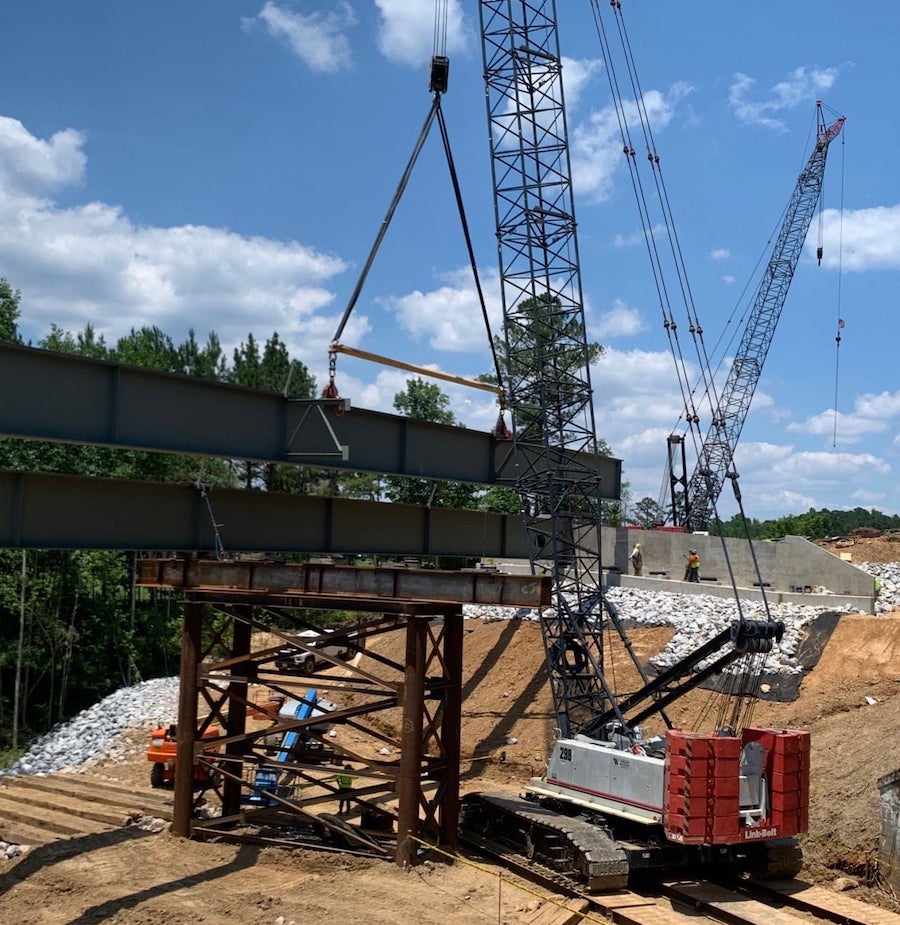
Applications for Lifting Beams and Spreader Beams
Lifting beams and spreader beams both boast a unique design tailored to specific challenges, ensuring safe and efficient handling of diverse loads. Although each piece of equipment is similar, each have their own specific scenarios and industries where they excel.
Spreader Beams
Spreader beams are specifically engineered to distribute the weight of a load between two primary lift points, making them particularly useful in certain lifting situations such as the following scenarios:
- Lifting long loads: Given their design, spreader beams are ideal for lifting objects that are elongated. The beam’s length and the distance between the two primary lifting points help prevent the load from sagging in the middle, ensuring that the weight is evenly distributed.
- Handling flexible loads: Flexible or limp materials—like certain types of machinery, fabric rolls, or some metal assemblies—can pose challenges when lifted. The design of spreader beams helps maintain the shape of such materials during the lifting process, preventing undue stress or potential damage.
- Lifting loads with multiple attachment points: Spreader beams are often equipped with multiple bottom slings or rigging systems. This feature makes them adept at handling loads that require several attachment points for balanced lifting.
- Stabilizing asymmetric loads: For objects that have an uneven weight distribution or an irregular shape, spreader beams can help maintain stability by adjusting the location or length of the bottom slings—ensuring the load remains level during the lift.
Given their versatility and capability, spreader beams find their place in various industries and settings:
- Construction: Spreader beams are invaluable when lifting long steel girders, precast concrete sections, or other elongated structural components.
- Shipbuilding: Large ships often require the lifting of long, heavy, or irregularly shaped components. Spreader beams can efficiently handle such tasks, ensuring that parts are placed with precision.
- Manufacturing plants: Machinery or parts that are long or flexible are often moved or repositioned using spreader beams, ensuring safety and reducing the risk of damage.
- Oil and gas industry: When installing or maintaining pipelines, especially those that are long and need to be kept straight, spreader beams are often the tool of choice.
- Wind energy sector: The long blades of wind turbines can be challenging to lift, especially during installation or maintenance. Spreader beams provide the necessary support and stability for such operations.
- Transport and logistics: For transporting or shifting unusually long or flexible cargo, spreader beams can be used to ensure the load remains stable during crane operations at ports or transport hubs.
Lifting Beams
Lifting beams, with their unique design featuring a singular top lifting point and multiple bottom attachment points, are particularly suited for specific lifting challenges. Some of their ideal applications include:
- Limited headroom: Due to their more compact vertical design, lifting beams are especially useful in environments where overhead space is restricted. Their direct attachment design minimizes the vertical space needed for operations.
- Multiple attachment points required: When a load demands several points of attachment—either due to its size, shape, or weight distribution—lifting beams come into their own. Their multiple bottom attachment points provide the flexibility to securely and safely lift such loads.
- Managing bending and shear stresses: In situations where the load’s weight distribution can induce bending moments and shear stresses on the lifting apparatus, lifting beams—with their robust construction—are the ideal choice.
- Handling loads with varied geometry: If the load has an irregular shape or varied geometry, lifting beams can be adapted with custom attachment hardware—making them versatile for unconventional lifting tasks.
- Lifting loads close to the crane: Lifting beams allow the load to be held closer to the lifting mechanism, which can be beneficial when precision is required—such as in assembly lines or during installations.
Lifting beams, with their unique characteristics, are indispensable in several industries and specific tasks:
- Aerospace: In aircraft assembly or maintenance, lifting beams can be used to move large components like wings or engines—especially in hangars with limited headroom.
- Automotive manufacturing: As vehicles move down assembly lines, lifting beams can precisely position heavy parts like engines or chassis components.
- Warehousing and storage: In environments with tight aisles and limited vertical space, lifting beams help in stacking and moving heavy items efficiently.
- Mining: Underground mining operations often have constrained spaces. Lifting beams assist in hoisting equipment, machinery, or extracted materials within these tight confines.
- Urban construction: In city environments, where buildings are closely spaced and there’s limited overhead space, lifting beams facilitate the safe and efficient movement of construction materials.
- Railway maintenance and construction: For tasks like lifting sections of rail tracks or large components of train engines, lifting beams offer the stability and precision required.
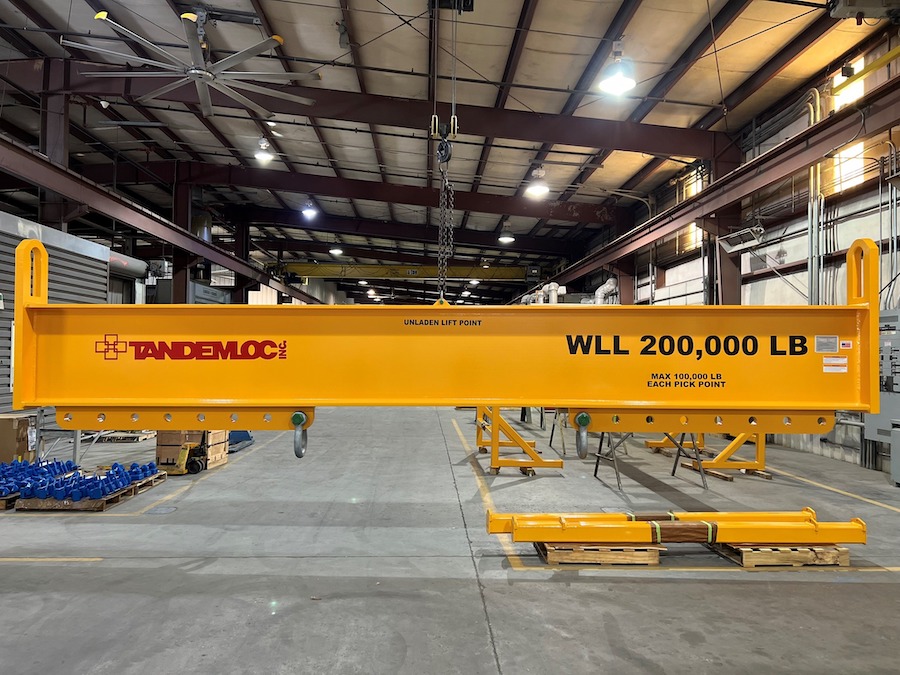
Safety Considerations for Lifting Beams and Spreader Beams
The center of gravity (CoG) is crucial in lifting operations, determining load stability and the safety of personnel. However, understanding CoG is just the starting point. Regular maintenance and inspection of equipment, whether spreader beams or lifting beams, are vital for ensuring longevity and operational safety.
Load Stability
The center of gravity (CoG) is a fundamental concept in lifting operations, referring to the point in an object or load where its weight is equally distributed in all directions. For both spreader beams and lifting beams, accurately identifying and accounting for the CoG is crucial. When a load is lifted, the force exerted by the lifting device—whether it’s a crane or a hoist—needs to act through the object’s CoG to ensure the object remains stable and doesn’t tilt or rotate. A miscalculation or misunderstanding of the CoG can lead to unbalanced forces during lifting, posing significant risks.
Spreader beams are designed to distribute a load’s weight across their length, primarily handling compressive forces. Their configuration ensures that longer or more flexible loads remain stable during the lifting process. However, potential risks arise when:
- The CoG of the load shifts, possibly due to the load’s contents moving or being unevenly distributed.
- There is a misalignment in the connection points on the spreader beam, causing an uneven distribution of the load’s weight.
- The beam is not properly configured for the shape or flexibility of the load, leading to an inability to maintain the load’s stability.
Lifting beams, with their direct attachment points underneath, are subjected to both bending and shear stresses. The importance of understanding the CoG becomes even more pronounced because:
- The multiple bottom attachment points need to align with the CoG to prevent torsional stresses and maintain stability.
- A shift in the CoG can induce bending moments on the beam, possibly leading to structural failures if not anticipated.
- The singular top attachment point means that any miscalculation in the CoG can quickly lead to the load tipping or rotating, making precise positioning critical.
Potential risks to consider:
- Uncontrolled movements: Misjudging the CoG can result in the load swinging, rotating, or tilting unexpectedly—endangering personnel and equipment.
- Structural failures: Both types of beams are designed based on certain weight distribution assumptions. An unanticipated shift in the CoG can lead to stresses beyond what the beam can handle, potentially causing it to fail.
- Drop hazards: An unstable load can slip or become detached, posing significant drop hazards—especially in congested or populated work areas.
- Operational delays: Constant adjustments due to stability concerns can lead to operational inefficiencies and project delays.
Inspection and Maintenance
The performance and safety of any lifting operation are only as dependable as the equipment used. Both spreader and lifting beams are subjected to significant stresses during their operational life—making regular inspection and diligent maintenance not just recommended, but essential. Failure to adhere to stringent inspection protocols can result in decreased safety margins, potential equipment failures, and unplanned operational downtimes.
Consider the following general maintenance for lifting beams and spreader beams:
- Visual inspection: Before any lifting operation, a visual inspection of the beam should be carried out. This includes checking for any visible signs of wear, tear, corrosion, or deformation.
- Load test: Periodically, and especially after any repair, a load test should be conducted to ensure the beam can handle its rated capacity.
- Weld inspection: Over time, weld points can be areas of vulnerability. Regular non-destructive testing, like ultrasonic or magnetic particle inspection, can identify potential weak spots or fractures.
- Documented checks: All inspections and maintenance procedures should be systematically documented. This helps in tracking the beam’s health over time and ensures compliance with relevant safety regulations.
Specific considerations for spreader beams include:
- Adjustment mechanisms: Given that many spreader beams are adjustable, it’s vital to inspect and maintain the mechanisms that allow for this adjustability. Ensure that the locking pins, sliders, or other mechanisms move smoothly and are free from obstructions or wear.
- Sling and rigging inspection: The slings and other rigging systems used with spreader beams should be inspected for any signs of fraying, tearing, or other damage. Their integrity is crucial for a safe lift.
Specific considerations for lifting beams include:
- Attachment points: The multiple bottom attachment points in lifting beams should be closely inspected for any signs of wear or deformation. Ensure that any hardware associated with these points, such as hooks or shackles, is in good condition.
- Bending and shear stress points: Given that lifting beams undergo both bending and shear stresses, particular attention should be given to areas most likely to experience these forces. This means checking the central sections of the beam, as well as the regions near the top and bottom attachment points.
Conclusion
As we’ve explored, both lifting beams and spreader beams serve as cornerstones of the heavy lifting industry—each tailored to address specific lifting challenges. While they might seem similar at first glance—their structural distinctions, load distribution techniques, and ideal applications set them apart. Understanding these differences is paramount for contractors aiming to maximize efficiency and safety in their operations.
View the complete article here.
What is the key difference between lifting beams and spreader beams?
The primary difference is in their design and load distribution – spreader beams distribute weight across two points for stability in lifting long or flexible loads, while lifting beams have a singular top lifting point and multiple bottom lifting points for handling varied load sizes and shapes.
What are the safety considerations for lifting beams and spreader beams?
Safety considerations include accurate identification of the center of gravity (CoG), potential risks like uncontrolled movements and structural failures, regular inspection for wear, tear, and corrosion, load testing, and documented checks to ensure compliance with safety regulations.






































